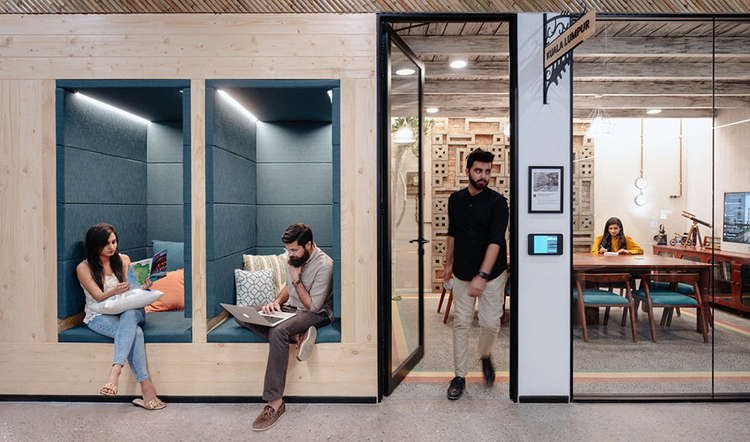5 Cool Offices Designed To Inspire
A modern office environment involves more than open plans and hot desking. It’s about creating a mixture of adaptable spaces that are relaxed and intimate, offering employees comfortable, less formal settings that support positive, productive teamwork.

This article is part of our October 2018 series about the state of design and creativity. Click here for more.
Just as technology is changing the workplace, so, too, is the environment changing itself, in favour of adaptable spaces that are relaxed and intimate, offering employees comfortable settings that support positive, productive teamwork.
In some parts of APAC, the move to residential-style fit-outs and hospitality settings is becoming increasingly popular. Spaces that promote productivity are high on the agenda, as are inclusive workspaces that encourage creativity and collaboration. Companies are also becoming more mindful of the health and well-being of staff—studies have shown a strong correlation between the two and improved productivity.
Heading into the office has never been so inspiring. Here are some of our favourite spaces throughout the region.
1. Dot Loves Data
The data scientists and creative storytellers at Dot Loves Data operate at the intersection of analytics and creativity, which makes an imaginative workspace something of a necessity. The New Zealand company chose an iconic warehouse space, transformed with some notable highlights, including a gin bar.
Employees can bring their work to the bar or simply relax and recharge before heading back to a cosy nook, hammock, or swing chair for some independent work, or to breakout spaces with comfortable sofas. There’s an adaptable meeting space with retractable doors, giving workers the flexibility to use for both a private or collaborative working space. The meeting room also doubles as a fully fitted out music room, to get the creative juices flowing.
Dot’s office also boasts a gym and yoga studio, a massage room (yes, staff get one per week), and even an indoor cricket pitch.
2. Vision Australia
Designing any interior comes with its own set of challenges—perhaps none more so than for nonprofit Vision Australia and its 5,500-sqm of office, retail, and event space. The company employs 240 visually impaired employees and also needs to facilitate members of the general public and visitors.
To create the perfect space, Vision Australia first worked with the designers in “immersion sessions” to help them better understand the experience of being visually impaired and the specific, typical design issues that cause problems.
The results? Surfaces that were typically hard were replaced with soft, smooth edges and tactile surfaces, including the walls. The use of bold colours to visually differentiate areas was a priority. Consideration was given to contrasting colours, curved detailing, and wayfinding solutions, creating a multisensory environment to ensure visually impaired employees can safely and independently navigate their surroundings.
3. Airbnb
Airbnb’s core ethos is “Belong Anywhere,’’ an inclusive philosophy, from marketing efforts to organisational culture that permeates the organisation. The phrase also was top of mind when it recently chose an industrial warehouse space for a new global facility in Gurgaon, India.
In addition to infusing local themes into the workspace design, creating spaces for employees to better collaborate was key. As such, the designers incorporated individual and unique breakout spaces. Staff can choose where they will be most productive, from open community spaces and rooftop multifunction zones to small meeting rooms and private alcoves.
4. Atlassian
Multiple studies, one even by__ NASA,__ have shown the positive impact that indoor plants have on air quality. Their inclusion also is said to have a range of health benefits for employees, including a positive shift in mental health and overall well-being, leading to fewer sick days.
What’s more, according to the Human Spaces report, interiors with greenery and natural light can boost workplace productivity by 6% and increase creativity by 15%, making their use more than just a design feature.
None of that has been lost on Australian software maker Atlassian, where creating and sustaining a positive, healthy workspace is a commitment the company has made to its famously tight-knit workforce. In fact, the entire space has the theme of “team” and has been designed around the employees to encourage collaboration.
5. Greenhouse
With the gig economy thriving in APAC, we can expect to see more freelance, temporary, and independent contractors on the horizon. Rather than them working independently from home, co-working spaces are becoming a popular solution for those who still enjoy the sociability of the workplace. What’s more, research has shown that co-working environments made 68% of entrepreneurs more focused, 64% more productive, and 90% more confident.
Greenhouse, located in Jakarta, not only provides flexible and functional co-workspaces, but it’s also taking the concept to new heights—literally. Perched on its building’s 25th floor, the 1,800-sqm penthouse space provides a breathtaking, 360-degree view of Jakarta’s skyline. It’s contemporary in its design aesthetic and houses more than 200 plants, creating an incredible living greenhouse.
As for workspace options, Greenhouse makes available flexible solutions with dedicated desks, hot desks for sharing, and private workspaces. The space can also be used as a registered business address, with on-site business services such as secretarial, legal, and accounting.
Greenhouse is so dedicated to creating a professional community that it runs free classes and workshops for its members on everything from meditation to product marketing, as well as holds regular networking and social events. This encourages members to create meaningful connections with one another.